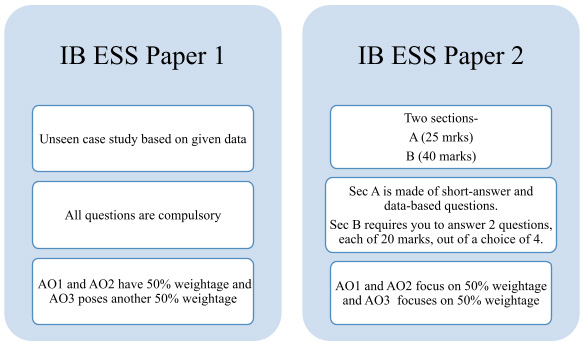
IB Environmental System and Societies (ESS) is a transdisciplinary group 3 and 4 IB course, offered only at the IB standard level (SL). You, as an ESS taker, must be wondering why ESS is considered to be a transdisciplinary subject. The answer is well explanatory. IB ESS encompasses round knowledge, key concepts, tools, and research approaches involved in sciences and individuals and societies. IB ESS is a complex study of Geography, Ecology, Environmental Science, Chemistry and even Physics. All the IB subjects which IB ESS connects with belong to either group 3 or group 4 IB courses.
IB ESS explores the structure and function of environmental systems. At the same time, it also explores the social, political, economic, cultural, and ethical interactions of different societies present in the environment. That’s where the IB subject owes its name- Environmental System and Societies.
ESS deals with a wide variety of environmental problems and issues we encounter in everyday life. Starting from climate change to global warming, pollution, environmental value systems, communities and ecosystem, biomes, food production system, and the list is still on. A comprehensive analysis of natural and artificial processes in the environment, ESS throws light on big issues like global warming, ozone layer depletion, ocean acidification, overpopulation, climate changes, energy transition, biodiversity, deforestation, tropical rainforests, deserts, endangered species, plastic pollution, ecosystem, and so on. An overview of the ESS syllabus would tell you that the subject is all to do with the natural and artificial processes in the environment. Yes, it makes us aware of the environmental issues. The focus of IB ESS is on the anthropogenic impact locally and globally.
There are certain quantitative research methods like laboratory experiments, field experiments, quasi-experiments, natural experiments, correlations research. The laboratory experiment deals with the cause effect relationship between the independent (IV) and dependent variable (DV). Field, natural, and quasi-experiments have ecological validity. The correlations research uses quantitative data which might be difficult to manipulate experimentally.
IB ESS banks on certain pivotal concepts like sustainability, equilibrium, strategy, biodiversity. The big questions re-examine the concepts while introducing topics, integrating classroom discussions and student assignments, retrospective or review analysis on the topic. The systems approach is all to do with a comprehensive explanation of interconnections between interdisciplinary learnings. This approach deepens our understanding of complex and dynamic ecosystems, bringing in new content into the prevalent knowledge.
IB ESS syllabus
Syllabus component | Recommended teaching hours |
Core content | 120 |
Topic 1— Foundations of environmental systems and societies | 16 |
Topic 2—Ecosystems and ecology | 25 |
Topic 3—Biodiversity and conservation | 13 |
Topic 4—Water and aquatic food production systems and societies | 15 |
Topic 5—Soil systems and terrestrial food production systems and societies | 12 |
Topic 6—Atmospheric systems and societies | 10 |
Topic 7—Climate change and energy production | 13 |
Topic 8—Human systems and resource use | 16 |
Practical scheme of work | 30 |
Practical activities | 20 |
Individual investigation | 10 |
Total teaching hours | 150 |
Practical work in IB ESS
Practical work is an important assessment component of the IB ESS course, whether in the laboratory, classroom, or out in the field. Practical work gives an opportunity for students to gain and develop skills and techniques which may be beyond the assessment model.
Use of mathematics in IB ESS
The use of mathematics in the study of IB ESS is reasonably fundamental-comprising of proportion, arithmetic operations, algebraic equations, use of graphs, and interpretation of data through the figurative diagrams and representations.
IB ESS online tutoring and notes
In Year 1 and 2 of your IBDP, you get a constant hand holding from the IB experts and examiners in a flexible and customized set up. So, don’t miss out, in case you need assistance.
The online notes are very handy with a synopsis of all the key concepts from each of the topics. Let me just give a hint on getting an idea of the terms discussed in topic 1 (Environmental Value Systems)
- History of environmental movement
- Examples of disasters like Gulf of Mexico Oil Spill, Rachel Carson’s Silent Spring
- Environmental value systems like ecocentric, anthropocentric, techno centric
- Environmental systems like open, closed, and isolated
- Systems and models
- Energy and equilibria-positive and negative feedback, tipping points, steady-state and unstable equilibrium
- Concepts on resilience and sustainability
- Human and pollution-bioaccumulation, bio magnification, DDT, altering human activity, controlling release, restoration
IB ESS Assessment-External (EA) and Internal (IA)
External assessment has two papers and constitute 75% of the total score. Paper 1 comprises of 40 marks with a 25% weightage and duration of 1 hour. Paper 2 comprises of 2 hours with a 50% weightage and duration of 2 hours.
Internal Assessment in IB ESS is dealt for 10 instruction hours and counts for 25% of the total score.

IB ESS IA
IB ESS IA focuses on a particular aspect or issue and connects the research work to a broader environmental and social context. The IA is an individual research record, comprising of 1500-2250 words. IBESS IA has the following assessment criteria:
- Identification of the context (6 marks, 20%)
- Plan the investigation (6 marks, 20%)
- Results, analysis, and conclusion (6 marks, 20%)
- Discussion and evaluation (6 marks, 20%)
- Applications (3 marks, 10%)
- Communication (3 marks, 10%)
COMPONENTS | MARKS | WEIGHTAGE |
Identification of the context | 6 | 20% |
Planning the investigation | 6 | 20% |
Results, analysis, and conclusion | 6 | 20% |
Discussion and evaluation | 6 | 20% |
Applications | 3 | 10% |
Communication | 3 | 10% |
Total | 30 | 100% |
We would progressively delve deep into the tips on scoring the perfect score in IB ESS IA.
